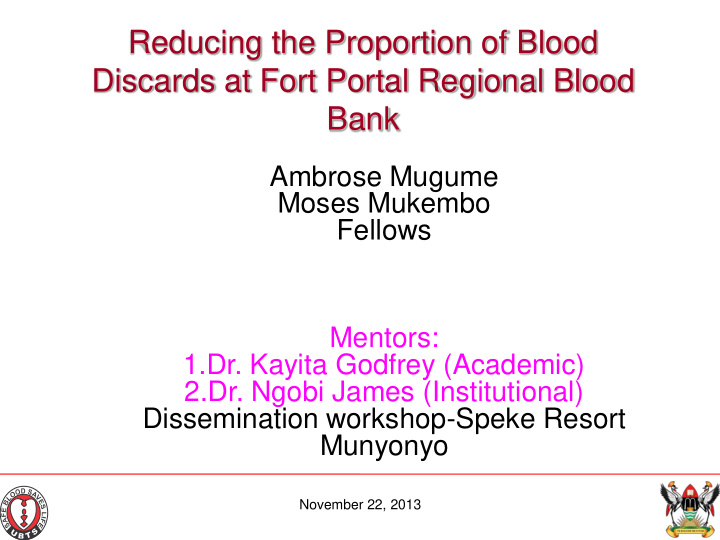



Reducing the Proportion of Blood Discards at Fort Portal Regional Blood Bank Ambrose Mugume Moses Mukembo Fellows Mentors: 1.Dr. Kayita Godfrey (Academic) 2.Dr. Ngobi James (Institutional) Dissemination workshop-Speke Resort Munyonyo November 22, 2013 1
Introduction • Uganda Blood Transfusion Service (UBTS) - Ministry of health • It has 7 regional blood banks including Fort Portal • UBTS collects, tests and distributes safe blood in Uganda • Donated blood at UBTS is screened at the laboratory • Blood discards are mainly due to transfusion transmissible infections • November 22, 2013 2 •
Problem • 676(9.8%) of 6,924 units collected were discarded between October 2012 and March 2013 – 40% - hepatitis B – 35% - HIV – 12% - Inadequate volume – 5% - hepatitis C – 8% - others • 5% is acceptable discard rate by UBTS Blood ready for discard November 22, 2013 3
Problem cont’d • Approximate cost of a unit of blood= USH70,000 (USD28) • At least USH18,900,000 (USD 7,560) was lost due to hepatitis B blood discards in the period • Loss of a precious resource by the blood donor November 22, 2013 4
Project objectives General objective • Reduce the proportion of blood discards due to hepatitis B at Fort Portal regional blood bank Specific objectives • To reduce hepatitis B discards from 40% to 15% by Oct 2013 • Strengthen the blood donor selection process • To reduce costs due to high blood discards November 22, 2013 5
Project implementation • Introduced pre donation screening for hepatitis B • Trained 11 staff on hepatitis B rapid testing • Standard operating procedures for on site screening developed • Referral form introduced in the field • Work flow charts were put in place November 22, 2013 6
Out comes Before After Percentage current discards Percentage baseline discards 7.8 4 12 9 27 35 4 5 32.5 23 40 HIV Hepatitis B Hepatitis C Syphilis Inadequates HIV Hepatitis B Hepatitis C Syphilis Inadequates Expired November 22, 2013 7
Key project Outcomes • Hepatitis B discards reduced from 40% to 23% • 81 of 2,419 blood donors tested were deferred for hepatitis B • Observed unintended reduction in discards due to HIV, expiry and inadequate blood volume • Net saving of USH3,670,000 (USD1,468) made in 4 months November 22, 2013 8
Lessons learnt • The intervention can be applied in communities with a high viral prevalence • Positive association between Hepatitis B and HIV • Instant hepatitis B checks makes pre and post donation counseling easier November 22, 2013 9
Challenges and counter measures No Challenge Counter measure 1 Referral of hepatitis B Introduction of a referral form. positive donors Captured telephone numbers 2 Follow up difficulties of referred blood donors 3 Limited time in schools Teacher education to give more time 4 Confidentiality issues Strengthened pre donation education 5 Long queuing of blood Need extra man power/ donors at hepatitis B trained volunteers screening point November 22, 2013 10
Recommendations • Scale up pre donation screening • Reduce blood discards due to Hepatitis C • Introduce free/routine hepatitis B vaccination to blood donors • Target populations most affected by Hepatitis B virus • UBTS review of Standard operating procedures November 22, 2013 11
Conclusion • Pre donation screening for Hepatitis B reduced blood discards by 42.5% in 4 months • Strengthened the blood donor selection process and also had unintended benefits • Reduced costs by USH3,670,000 (USD1,468) at Fort Portal regional blood bank November 22, 2013 12
Acknowledgements • Management of Uganda Blood Transfusion Service • Fort Portal regional blood bank staff • MakSPH-CDC Fellowship staff – Mr Matovu, Ms Stella and Ms Faridah • Academic mentors – Dr Kayita Godfrey - Mr Enock Kizito • Institutional mentor – Dr Ngobi James • CQI Fellows of 2013 cohort November 22, 2013 13
Recommend
More recommend